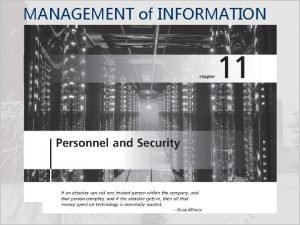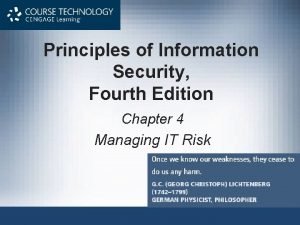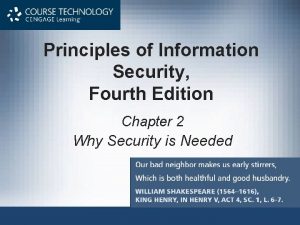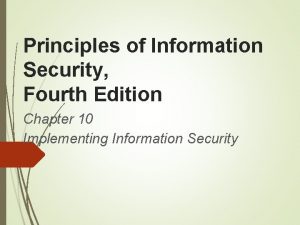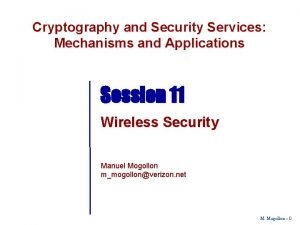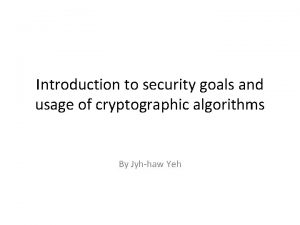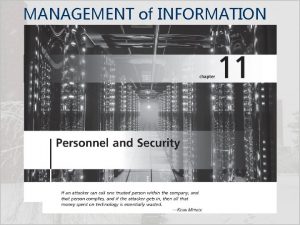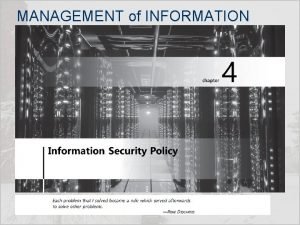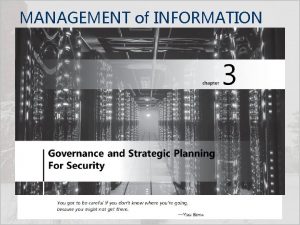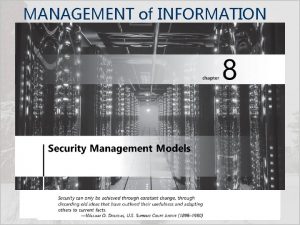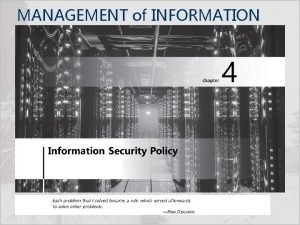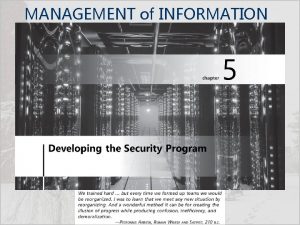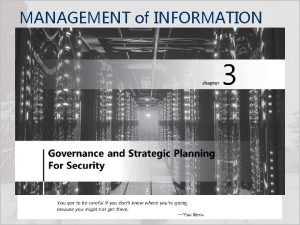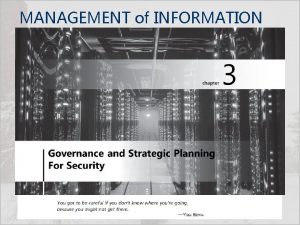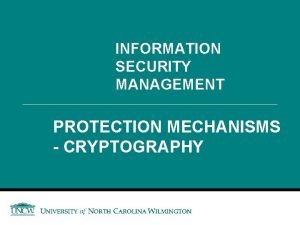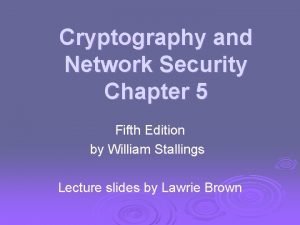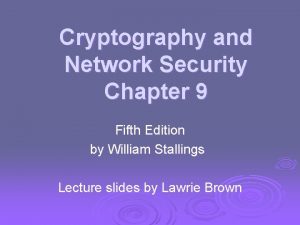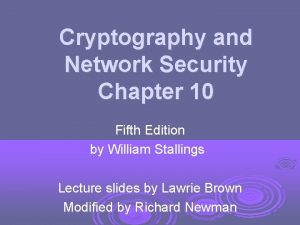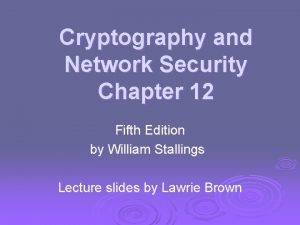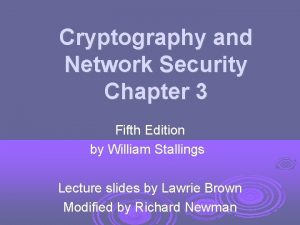MANAGEMENT of INFORMATION SECURITY Fifth Edition CRYPTOGRAPHY Management































- Slides: 31

MANAGEMENT of INFORMATION SECURITY, Fifth Edition

CRYPTOGRAPHY Management of Information Security, 5 th Edition, © Cengage Learning 2

Cryptography • Encryption is the process of converting an original message into a form that cannot be understood by unauthorized individuals • Cryptology, the science of encryption, encompasses two disciplines: cryptography and cryptanalysis – Cryptography—from the Greek words kryptos, meaning “hidden, ” and graphein, meaning “to write”—describes the processes involved in encoding and decoding messages so that others cannot understand them – Cryptanalysis—from analyein, meaning “to break up”—is the process of deciphering the original message (or plaintext) from an encrypted message (or ciphertext), without knowing the algorithms and keys used to perform the encryption Management of Information Security, 5 th Edition, © Cengage Learning 3

Encryption Definitions • Algorithm: the mathematical formula or method used to convert an unencrypted message into an encrypted message • Cipher: the transformation of the individual components (characters, bytes, or bits) of an unencrypted message into encrypted components • Ciphertext or cryptogram: the unintelligible encrypted or encoded message resulting from an encryption Management of Information Security, 5 th Edition, © Cengage Learning 4

Encryption Definitions (cont. ) • Cryptosystem: the set of transformations necessary to convert an unencrypted message into an encrypted message • Decipher: to decrypt or convert ciphertext to plaintext • Encipher: to encrypt or convert plaintext to ciphertext • Key: the information used in conjunction with the algorithm to create the ciphertext from the plaintext; it can be a series of bits used in a mathematical algorithm, or the knowledge of how to manipulate the plaintext Management of Information Security, 5 th Edition, © Cengage Learning 5

Encryptions Definitions (cont. ) • Keyspace: the entire range of values that can possibly be used to construct an individual key • Plaintext: the original unencrypted message that is encrypted and results from successful decryption • Steganography: the process of hiding messages, usually within graphic images • Work factor: the amount of effort (usually expressed in hours) required to perform cryptanalysis on an encoded message Management of Information Security, 5 th Edition, © Cengage Learning 6

Common Ciphers • In encryption, the most commonly used algorithms include three functions: substitution, transposition, and XOR • In a substitution cipher, you substitute one value for another – A monoalphabetic substitution uses only one alphabet – A polyalphabetic substitution uses two or more alphabets Management of Information Security, 5 th Edition, © Cengage Learning 7

Common Ciphers • The transposition cipher (or permutation cipher) simply rearranges the values within a block to create the ciphertext – This can be done at the bit level or at the byte (character) level • In the XOR cipher conversion, the bit stream is subjected to a Boolean XOR function against some other data stream, typically a key stream – XOR works simply, if the two values are the same, you get “ 0”; if not, you get “ 1” – This process is reversible; that is, if you XOR the ciphertext with the key stream, you get the plaintext Management of Information Security, 5 th Edition, © Cengage Learning 8

Book or Running Key Cipher • Another method, used in the occasional spy movie, is the use of text in a book as the algorithm to decrypt a message • The key relies on two components: – Knowing which book to use – Having a list of codes representing the page number, line number, and word number of the plaintext word Management of Information Security, 5 th Edition, © Cengage Learning 9

Symmetric Encryption • Each of the methods of encryption and decryption described requires that the same algorithm and key are used to both encipher and decipher the message • This is known as private key encryption, or symmetric encryption • In this approach to encryption, the same key—a secret key —is used to encrypt and decrypt the message • Symmetric encryption methods are usually extremely efficient, requiring easily accomplished processing to encrypt or decrypt the message • One challenge in symmetric key encryption is getting a copy of the key to the receiver, a process that must be conducted out-of-band to avoid interception Management of Information Security, 5 th Edition, © Cengage Learning 10

Symmetric Encryption Management of Information Security, 5 th Edition, © Cengage Learning 11

Asymmetric Encryption • Asymmetric encryption, also known as public key encryption, uses two different keys, but related keys • Either key can be used to encrypt or decrypt the message • However, if Key A is used to encrypt the message, then only Key B can decrypt it; conversely, if Key B is used to encrypt a message, then only Key A can decrypt it • This technique is most valuable when one of the keys is private and the other is public • The problem with asymmetric encryption is that it requires four keys to hold a single conversation between two parties, and the number of keys grows geometrically as parties are added Management of Information Security, 5 th Edition, © Cengage Learning 12

Asymmetric (Public Key) Encryption Management of Information Security, 5 th Edition, © Cengage Learning 13

Digital Signature • When the asymmetric process is reversed—the private key encrypts a message, and the public key decrypts it—the fact that the message was sent by the organization that owns the private key cannot be refuted • This nonrepudiation is the foundation of digital signatures • Digital signatures are encrypted messages that are independently verified by a central facility (Registry) as authentic Management of Information Security, 5 th Edition, © Cengage Learning 14

Digital Signature • A digital certificate is an electronic document, similar to a digital signature, attached to a file certifying that the file is from the organization it claims to be from and has not been modified from the original format • A certificate authority (CA) is an agency that manages the issuance of certificates and serves as the electronic notary public to verify their origin and integrity Management of Information Security, 5 th Edition, © Cengage Learning 15

Digital Certificates Management of Information Security, 5 th Edition, © Cengage Learning 16

Public Key Infrastructure • Public key infrastructure (PKI) is the entire set of hardware, software, and cryptosystems necessary to implement public key encryption • PKI systems are based on public key cryptosystems and include digital certificates and certificate authorities • Common implementations of PKI include: – Systems that issue digital certificates to users and servers – Systems with computer key values to be included in digital certificates – Tools for managing user enrollment, key generation, and certificate issuance – Verification and return of certificates – Key revocation services – Other services associated with PKI that vendors bundle into their products Management of Information Security, 5 th Edition, © Cengage Learning 17

Public Key Infrastructure • PKI can increase the capabilities of an organization to protect its information assets by providing the following services: – Authentication: Digital certificates in a PKI system permit individuals, organizations, and Web servers to authenticate the identity of each of the parties in an Internet transaction – Integrity: A digital certificate demonstrates that the content signed by the certificate has not been altered while in transit – Confidentiality: PKI keeps information confidential by ensuring that it is not intercepted during transmission over the Internet – Authorization: Digital certificates issued in a PKI environment can replace user IDs and passwords, enhance security, and reduce some of the overhead required for authorization processes and controlling access privileges for specific transactions – Nonrepudiation: Digital certificates can validate actions, making it less likely that customers or partners can later repudiate a digitally signed transaction, such as an online purchase Management of Information Security, 5 th Edition, © Cengage Learning 18

Hybrid Systems • Pure asymmetric key encryption is not widely used except in the area of certificates; instead, it is typically employed in conjunction with symmetric key encryption, creating a hybrid system • The hybrid process in current use is based on the Diffie. Hellman key exchange method, which provides a way to exchange private keys using public key encryption without exposure to any third parties • In this method, asymmetric encryption is used to exchange symmetric keys so that two organizations can conduct quick, efficient, secure communications based on symmetric encryption • Diffie-Hellman provided the foundation for subsequent developments in public key encryption Management of Information Security, 5 th Edition, © Cengage Learning 19

Hybrid Encryption Management of Information Security, 5 th Edition, © Cengage Learning 20

Using Cryptographic Controls • While modem cryptosystems can certainly generate unbreakable ciphertext, that is possible only when the proper key management infrastructure has been constructed and when the cryptosystems are operated and managed correctly • For those organizations with the need and the capability to use cryptographic controls, they can be used to support several aspects of the business: – Confidentiality and integrity of e-mail and its attachments – Authentication, confidentiality, integrity, and nonrepudiation of e-commerce transactions – Authentication and confidentiality of remote access through VPN connections – A higher standard of authentication when used to supplement access control systems Management of Information Security, 5 th Edition, © Cengage Learning 21

E-Mail Security • Secure Multipurpose Internet Mail Extensions (S/MIME) builds on the Multipurpose Internet Mail Extensions (MIME) encoding format by adding encryption and authentication via digital signatures based on public key cryptosystems • Pretty Good Privacy (PGP) was developed by Phil Zimmerman and uses the International Data Encryption Algorithm (IDEA) cipher, a 128 -bit symmetric key block encryption algorithm with 64 -bit blocks for message encoding Management of Information Security, 5 th Edition, © Cengage Learning 22

Securing the Web • Secure Sockets Layer (SSL) – Developed by Netscape in 1994 to provide security for e-commerce transactions – Mainly relies on RSA for key transfer and on IDEA, DES, or 3 DES for encrypted symmetric key-based data transfer • Secure Hypertext Transfer Protocol (SHTTP) – Provides secure e-commerce transactions as well as encrypted Web pages for secure data transfer over the Web, using different algorithms Management of Information Security, 5 th Edition, © Cengage Learning 23

Securing the Web (cont. ) • Secure Shell (SSH) – Provides security for remote access connections over public networks by using tunneling, authentication services between a client and a server – Used to secure replacement tools for terminal emulation, remote management, and file transfer applications Management of Information Security, 5 th Edition, © Cengage Learning 24

Securing the Web • IP Security (IPSec) is the primary and now dominant cryptographic authentication and encryption product of the IETF’s IP Protocol Security Working Group • IPSec combines several different cryptosystems: – Diffie-Hellman key exchange for deriving key material between peers on a public network – Public key cryptography for signing the Diffie-Hellman exchanges to guarantee the identity of the two parties – Bulk encryption algorithms, such as DES, for encrypting the data – Digital certificates signed by a CA to act as digital ID cards Management of Information Security, 5 th Edition, © Cengage Learning 25

Securing the Web • IPSec has two components: – The IP Security protocol itself, which specifies the information to be added to an IP packet and indicates how to encrypt packet data – The Internet Key Exchange, which uses asymmetric key exchange and negotiates the security associations Management of Information Security, 5 th Edition, © Cengage Learning 26

Securing the Internet (cont. ) • IPSec works in two modes of operation: transport and tunnel – In transport mode, only the IP data is encrypted—not the IP headers themselves; this allows intermediate nodes to read the source and destination addresses – In tunnel mode, the entire IP packet is encrypted and inserted as the payload in another IP packet • IPSec and other cryptographic extensions to TCP/IP are often used to support a virtual private network (VPN), a private, secure network operated over a public and insecure network Management of Information Security, 5 th Edition, © Cengage Learning 27

Securing Authentication • A final use of cryptosystems is to provide enhanced and secure authentication • One approach to this issue is provided by Kerberos, which uses symmetric key encryption to validate an individual user’s access to various network resources • It keeps a database containing the private keys of clients and servers that are in the authentication domain that it supervises Management of Information Security, 5 th Edition, © Cengage Learning 28

Kerberos • Kerberos system knows these private keys and can authenticate one network node (client or server) to another • Kerberos also generates temporary session keys —that is, private keys given to the two parties in a conversation • Kerberos consists of three interacting services, all of which rely on a database library: – Authentication Server (AS) – Key Distribution Center (KDC) – Kerberos Ticket Granting Service (TGS) Management of Information Security, 5 th Edition, © Cengage Learning 29

Managing Cryptographic Controls • Don’t lose your keys • Know who you are communicating with • It may be illegal to use a specific encryption technique when communicating to some nations • Every cryptosystem has weaknesses • Give access only to those with a business need • When placing trust into a certificate authority, ask “Who watches the watchers? ” Management of Information Security, 5 th Edition, © Cengage Learning 30

Managing Cryptographic Controls • There is no security in obscurity • Security protocols and the cryptosystems they use are installed and configured by humans, and thus they are only as good as their installers • As with all other information security program components, make sure that your organization’s use of cryptography is based on well-constructed policy and supported with sound management procedures Management of Information Security, 5 th Edition, © Cengage Learning 31
 Cryptography and network security 6th edition
Cryptography and network security 6th edition Cryptography and network security 6th edition pdf
Cryptography and network security 6th edition pdf Cryptography and network security 4th edition
Cryptography and network security 4th edition Cryptography and network security pearson
Cryptography and network security pearson Wireless security in cryptography and network security
Wireless security in cryptography and network security Management of information security 5th edition
Management of information security 5th edition Principles of marketing fifth european edition
Principles of marketing fifth european edition Psychology ciccarelli 5th edition chapter 1
Psychology ciccarelli 5th edition chapter 1 Fundamentals of corporate finance fifth edition
Fundamentals of corporate finance fifth edition Democritus atomic model diagram
Democritus atomic model diagram Molecular biology of the cell
Molecular biology of the cell Molecular biology of the cell fifth edition
Molecular biology of the cell fifth edition Human anatomy fifth edition
Human anatomy fifth edition Human anatomy fifth edition
Human anatomy fifth edition Failure of supporting utilities and structural collapse
Failure of supporting utilities and structural collapse Principles of business information systems
Principles of business information systems Concentration risk
Concentration risk 12 principles of information security
12 principles of information security Bulls eye model in information security
Bulls eye model in information security Provate security
Provate security Visa international security model in information security
Visa international security model in information security Cnss model
Cnss model Cryptography security services
Cryptography security services Security services in cryptography
Security services in cryptography Introduction to network security and cryptography
Introduction to network security and cryptography Number theory in cyber security
Number theory in cyber security Firewall in cryptography and network security
Firewall in cryptography and network security Authentication in cryptography and network security
Authentication in cryptography and network security Intruders in cryptography and network security
Intruders in cryptography and network security Cryptography security goals
Cryptography security goals Primitive root in cryptography
Primitive root in cryptography Source
Source





